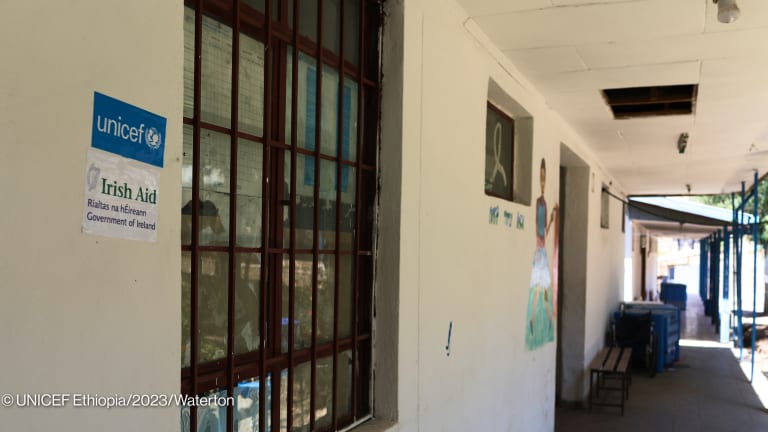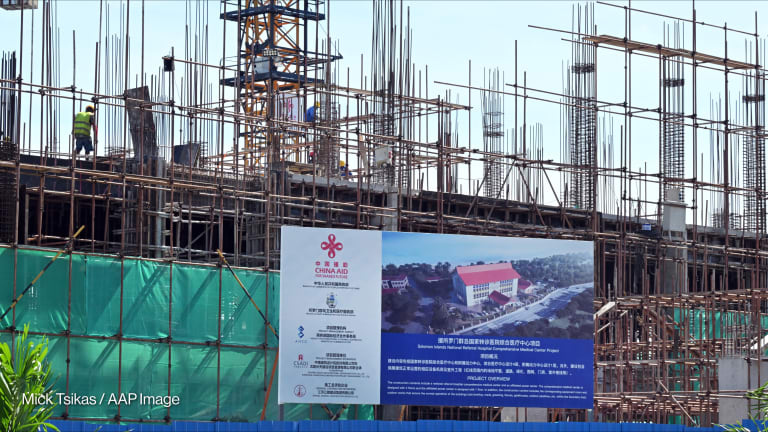Nordic aid donors: A primer
Denmark, Finland, Iceland, Norway, and Sweden spent $15 billion on official development aid in 2021. We looked into where they put their money — and what their plans are for the future.
Devex has reported extensively on aid donors from around the world — from their development and humanitarian activities to geographic and sectoral priorities. In this article, we look into five Nordic aid donors: Denmark, Finland, Iceland, Norway, and Sweden. Information is based on official sources, such as the donors’ websites, OpenAid, and the Organisation for Economic Co-operation and Development, as well as secondary sources, primarily Donor Tracker. We used the latest data available and converted the figures using average historical rates for the same year, which is either 2021 or 2022. This allows us to analyze the figures with respect to fluctuations in inflation rates, but it also means that the conversions may slightly differ from other sources. According to OECD final data, the five Nordic donors spent $15 billion on official development assistance in 2021, accounting for 8.1% of total ODA. Nordic countries included three of the five donors to hit the OECD’s 0.7% ODA-to-GNI target: Norway, with 0.93%; Sweden, with 0.91%; and Denmark, with 0.71%. Meanwhile, Finland allocated 0.47%, while Iceland spent 0.28%. 1. Sweden In 2021, Sweden spent $5.9 billion on ODA — or 0.91% of its gross national income. The Ministry of Foreign Affairs heads the development of policy and oversees the budget, while the Department for International Development leads the coordination. The Swedish International Development Cooperation Agency, or Sida, is MFA’s largest implementing partner. ODA in numbers According to OpenAid, Sida and MFA accounted for 97.5% of Swedish aid in 2021. Sida disbursed $3.3 billion, while MFA spent $2.5 billion. Nearly 40% of Sida’s budget, worth $1.3 billion, went to multilateral organizations, and another 38%, worth $1.2 billion, went to NGOs and civil society organizations. Afghanistan is the primary recipient country, with $115.3 million. The Democratic Republic of Congo ranked next, with $112.7 million, Somalia, with $106.6 million, then Mozambique, with $90.6 million. Multilaterals also accounted for most of MFA’s budget, with $2.2 billion, or 86.6%. The rest is divided among public and private institutions, NGOs, CSOs, and educational and research institutions. End of an era Sweden is often regarded as a development superpower. Since 1975, it has exceeded the 0.7% goal set by the United Nations, and since 2008, has committed to spending 1% of its GNI on aid. In 2015, it reached an exceptionally high net ODA of 1.4%. But this trend is unlikely to continue. In October, the government announced its plan of decoupling its ODA from the 1% target. The following month, it announced a SEK 7.3 billion ($721.4 million) reduction in the 2023 aid budget, and a further SEK 2.2 billion cut by 2024. The plan included two major changes: • To make parts of aid conditional on the recipient country’s willingness to cooperate on the return of failed asylum-seekers. • Reducing support to multilateral organizations, and prioritizing civil society organizations instead. The future of two important sectors — gender equality and climate change — also remains uncertain. In October, Sweden announced that it will no longer follow a feminist foreign policy — a strategy it pioneered in 2014. Although it was later reaffirmed that gender equality will remain an important goal, budget cuts are still expected. The government also abolished the Ministry of Environment, which handles its climate portfolio. This raises questions about the government’s adherence to its earlier commitment of expanding climate aid financing. 2. Norway Norwegian aid amounted to $4.7 billion in 2021 — 0.93% of its GNI. This is the country’s lowest ODA-to-GNI share since 2013. Its aid is mainly channeled through two agencies: the Ministry of Foreign Affairs, which defines the country’s development policy; and the Norwegian Agency for Development Cooperation, or Norad, an agency under MFA, which manages and implements its grants. ODA in numbers Of its total aid in 2021, NOK 23.2 billion ($2.7 billion) went to multilateral organizations. The rest is divided among nongovernmental organizations and the private and public sector. Syria received the biggest share among the countries, worth NOK 895.1 million. Other priorities are: Ethiopia, with NOK 759 million; Palestine, with NOK 693.9 million; and Afghanistan, with NOK 688.8 million. Meanwhile, NOK 13.7 billion was allocated for global projects. This included contributions to partnerships and funds, such as the Coalition for Epidemic Preparedness Innovations; Gavi, the Vaccine Alliance; and the Global Partnership for Education. A turn away from 1% Norway has committed to allocating 1% of its GNI to aid, making it one of the most generous donors in the development sphere. However, its 2023 proposed budget suggests a massive slash. Aid budget is currently pegged at NOK 43.8 billion, or just 0.75% of its GNI — its lowest percentage share since 1976. Norway cited the estimated high growth in the 2023 GNI as the primary reason for this exceptionally low ODA proportion. But this makes both national and international development organizations question the country’s move even more. The country is expected to earn NOK 1.38 trillion from oil and gas revenues — an 18% increase from 2022. Cuts will be mostly seen on regional grants. Budget for grants in Africa will be reduced by NOK 212 million, the Middle East and North Africa by NOK 175 million, and Europe and Central Asia by NOK 139 million. Despite this detour, Norway said that it will continue to increase its aid in the future until it reaches the 1% goal. 3. Denmark Denmark provided $2.9 billion of aid in 2021. Its ODA-to-GNI ratio slightly dipped compared to 2018 to 2020 levels — from 0.72% to 0.71%. The country has been providing at least 0.7% of its GNI to development aid since 1978 — reaching as high as 0.91% in 2010. Despite a downward trend in the last decade, it has committed to continue meeting the 0.7% target in the coming years. ODA in numbers According to OpenAid, Denmark spent DKK 12.6 billion ($2 billion) bilaterally, while DKK 5.7 billion ($907.2 million) went through multilateral agencies. Interregional projects received DKK 6.9 billion, followed by regional projects in Africa, worth DKK 3.5 billion, then contribution to European Union institutions, worth DKK 2.3 billion. Afghanistan is the biggest bilateral recipient, with DKK 534.5. Mali ranked next, with DKK 505.2 million; Syria, with DKK 362.5 million; and Ethiopia, with DKK 345.2 million. Danida and the future of Danish aid Denmark uses the term Danida — the Danish International Development Agency — to refer to its development activities. However development is funded via the Ministry of Foreign Affairs, and Danida is not a separate department within the ministry. Based on its new development cooperation strategy for 2021 to 2025 — named “The World We Share” — the country will focus on two priorities: social and institutional issues, including poverty and inequality, migration, and conflict and displacement; and climate change. These priorities were later reaffirmed through the 2022 expenditure framework for Danish development cooperation published in October 2021. The report outlined the country’s specific development goals: • From 2023, its climate-related assistance should account for 30% of its ODA. As a step toward this goal, Denmark proposed to increase its budget for green development in 2022 by DKK 400 million — bringing the total to DKK 3.4 billion, or about 24% of its ODA. • In 2025, the total budget for migration and fragile states should hit DKK 7.5 billion — an increase of DKK 3.5 billion. Denmark’s budget for irregular migration in 2022 amounted to DKK 5.6 billion. • Increasing ODA to Africa, reaching DKK 8 billion in 2025. 4. Finland Finland spent $1.4 billion on aid in 2021 — or 0.47% of its GNI. The Ministry of Foreign Affairs manages most of the ODA. The rest is disbursed through other government agencies and Finnfund — Finland’s development finance institution. ODA in numbers According to OpenAid, its ODA in 2021 primarily went through the multilateral system, worth €876.7 million ($1 billion). NGOs and CSOs received €129.9 million, while the rest was divided among public and private institutions. Afghanistan was the top bilateral recipient, with €28.7 million. Other priority countries included Ethiopia, with €26.3 million; Somalia, with €15.8 million; and Nepal, with €15 million. Slow growth in the coming years Finland appropriated €1.3 billion for aid in 2022 — or 0.5% of its GNI. Of this, €772 million went to MFA. The rest, worth €570 million, went to EU institutions, in-country refugee costs, civilian crisis management, Finnfund, and other development-related expenditures. The anticipated ODA share in the coming years is expected to decrease. From 0.5% in 2022, aid will remain at 0.45% until 2026. In monetary terms, ODA is expected to increase from €1.3 billion in 2023 to just €1.4 billion in 2026. Finland commits to gradually increasing its aid to 0.7% of its GNI by 2030. 5. Iceland Iceland’s ODA in 2021 amounted to $70.8 million — or 0.28% of its GNI. The Ministry of Foreign Affairs is the main actor for its development aid, with a fraction channeled through the Ministry of Finance and other government agencies. ODA in numbers According to OECD, the bulk of Iceland’s bilateral aid in 2021 went to regional projects, worth $30.2 million. Among the countries, Uganda received the biggest portion, worth $8.1 million, then Malawi, with $6.6 million. Iceland has implemented a unique approach to aid, implementing projects at a district level. This includes: • Maternal and newborn health, education, and water and sanitation projects in Mangochi district in Malawi. • Education and water and sanitation projects in Buikwe and Namayingo districts in Uganda. The future of Iceland’s international cooperation Although it commits to U.N.’s 0.7% target, Iceland has seen a rather slow growth in ODA contribution. Its ODA-to-GNI ratio remained below 0.3% in the last decade. For 2022, it set a target of 0.35%, and has pledged to allocate at least 0.2% to low-income states. Iceland set its priorities through its policy development cooperation for 2019 to 2023, focusing on human rights, gender equality, and sustainable development. Malawi, Sierra Leone, and Uganda are identified as bilateral partners, which will allow Iceland to directly participate in the development activities. Iceland also funds projects in other countries, including Mozambique, Ethiopia, Kenya, and Tanzania. Among the multilaterals, four are identified as main partners: the World Bank, UNICEF, UN Women, and United Nations Population Fund. Try out Devex Pro Funding today with a free five-day trial, and explore funding opportunities from over 850 sources in addition to our analysis and news content.
Devex has reported extensively on aid donors from around the world — from their development and humanitarian activities to geographic and sectoral priorities.
In this article, we look into five Nordic aid donors: Denmark, Finland, Iceland, Norway, and Sweden.
Information is based on official sources, such as the donors’ websites, OpenAid, and the Organisation for Economic Co-operation and Development, as well as secondary sources, primarily Donor Tracker.
This story is forDevex Promembers
Unlock this story now with a 15-day free trial of Devex Pro.
With a Devex Pro subscription you'll get access to deeper analysis and exclusive insights from our reporters and analysts.
Start my free trialRequest a group subscription Printing articles to share with others is a breach of our terms and conditions and copyright policy. Please use the sharing options on the left side of the article. Devex Pro members may share up to 10 articles per month using the Pro share tool ( ).
Miguel Tamonan is a Senior Development Analyst at Devex, where he analyzes data from public and private donors to produce content and special reports for Pro and Pro Funding readers. He has a bachelor’s degree in Political Science with a Major in International Relations from the Polytechnic University of the Philippines.








